Magical Yosemite in Winter
by Karen Misuraca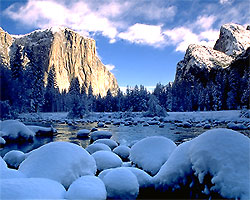 A light frosting of snow crunched under my boots as I walked the path along the Merced River. Just a few hundred yards from Yosemite Lodge in the heart of Yosemite National Park, I was alone in a tableau of ice-glazed cottonwoods and tall, bending, white grasses reflected in the dark mirror of the river. A rushing torrent filled with snowmelt in the spring, in mid-winter, the river barely sighs as she moves between softly mounded snowbanks. The only sounds were my crunching steps and the occasional thin plate of ice tweaking off the riverbank to float away.
A light frosting of snow crunched under my boots as I walked the path along the Merced River. Just a few hundred yards from Yosemite Lodge in the heart of Yosemite National Park, I was alone in a tableau of ice-glazed cottonwoods and tall, bending, white grasses reflected in the dark mirror of the river. A rushing torrent filled with snowmelt in the spring, in mid-winter, the river barely sighs as she moves between softly mounded snowbanks. The only sounds were my crunching steps and the occasional thin plate of ice tweaking off the riverbank to float away.
Rounding a bend into a frozen meadow, I gulped and my eyes filled with tears, as they always do, at the sight of El Capitan—the Snow King—the immense wall of silver-gray granite looming like a skyscraper into the blinding-blue sky. Topping out at 3,500 feet, four times as large as the Rock of Gibraltar, El Cap is said to be the largest single block of exposed granite in the world. An unforgettable sight glistening in the winter sun, El Cap is a relic of an Ice Age, two or three million years ago, when glaciers ripped through this valley leaving the famous monoliths, domes and peaks—Half Dome, Cathedral Spires, Royal Arches and many more—that we see today.
Fumbling with my camera, I looked up to see a coyote standing on the stone bridge, about fifty feet away. We locked eyes, I held my breath. He was warm in his thick, palegolden fur coat, and supremely confident, while I shivered in my (fake) fur-collared parka. With a twitch of his ears, he finally tiptoed away like a ghost into a snowy meadow.
Coyotes, mule deer, raccoons, the occasional black bear and other wildlife are easily sighted at this time of year when the deciduous trees and shrubs are bare and few people are driving, biking and walking around. At 4,000 feet in elevation, the valley receives less than thirty inches of snow through the season, just enough to lightly decorate the landscape. This is my favorite time of year to be here, for when the snow flies, the number of visitors drops dramatically and I feel as though I have the place to myself. The average daytime temperature is in the low-fifties and skies are often sparkling and sunny, perfect for walks, and when the snow sticks, for snowshoeing. Many visitors stay warm by hopping on and off the free shuttle buses that cruise the valley floor. 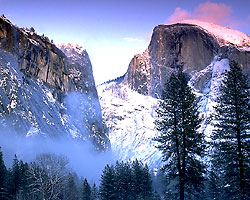 Just as a storm is clearing, when mists wreathe the peaks and spires, is an exciting time to tour and photograph the valley. Starting from the Ansel Adams Gallery in Yosemite Village are free, two-hour guided photography walks that showcase the snow-dressed pines and icy waterfalls, lacy aspens, and the magical reflections in the Merced River.
Just as a storm is clearing, when mists wreathe the peaks and spires, is an exciting time to tour and photograph the valley. Starting from the Ansel Adams Gallery in Yosemite Village are free, two-hour guided photography walks that showcase the snow-dressed pines and icy waterfalls, lacy aspens, and the magical reflections in the Merced River.
After a few days of dry weather, the first half-mile or so of the lower Yosemite Falls trail makes for a great winter hike. An easy paved and boardwalk trail also meanders through a woodland at the base of the falls. The most visited site in the park, the entire viewing area at the base of Yosemite Falls has recently been transformed, with habitat restored, and new footpaths and handicapped-accessible nature trails laid out. Massive wooden benches, stone walls and boulder alcoves have created a tranquil, forest kingdom from which to enjoy the thrilling rush of the tallest waterfall in North America. In the wintertime, the double avalanche of water dropping 2,425 feet is much diminished, yet, still magnificent. Ice cones as large as 300 feet high form on the ledge between the two cataracts, and when the sun warms at midday, the ice often cracks, thundering across the valley as it bursts.
With icicle-clad Half Dome looking on from above, ice-skating is fun to try or to watch at the outdoor rink in Curry Village. Sidle into the warming hut, hang out at the fire pit, have a hot drink and a snack, or rent skates and waltz around the rink.
Winter is the coziest time of year in the park indoors. My husband, Michael, and I love to sip hot buttered rums while toasting our toes at the round fireplace in the Mountain Room Lounge at Yosemite Lodge, with Yosemite Falls a whisper of its summer self visible beyond the tall windows. Our grandkids crowd around the fire to roast marshmallows and make sÕmores. At the lodge in the evenings is the delightful live show, "The Spirit of John Muir: Stories of Ice and Snow," starring the legendary portrayer of John Muir, actor Lee Stetson, who spins tales and relives Muir's daring winter adventures. 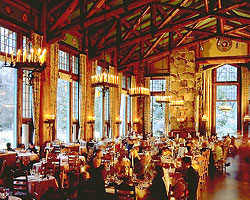 In Curry Village, an encampment of wooden cabins and tent cabins open weekends and holidays in the winter, campers gather in rocking chairs by the fireplace in the nostalgic old lounge building, where vintage photos and artifacts call for a stroll around the room. Under the incense cedars, Kellogg oaks and Jeffrey pines in the eastern end of the valley at the foot of Glacier Point, Curry Village was established in 1899, and is the camp that many people remember from their childhoods.
In Curry Village, an encampment of wooden cabins and tent cabins open weekends and holidays in the winter, campers gather in rocking chairs by the fireplace in the nostalgic old lounge building, where vintage photos and artifacts call for a stroll around the room. Under the incense cedars, Kellogg oaks and Jeffrey pines in the eastern end of the valley at the foot of Glacier Point, Curry Village was established in 1899, and is the camp that many people remember from their childhoods.
The glow of stained glass warms contented guests in the Great Lounge of the Ahwahnee Hotel as they gaze from their armchairs at the blazing logs in the giantsized, stone fireplaces. A masterpiece of Art Deco and California Craftsman architecture, the monumental Ahwahnee opened in 1927. Priceless Native American baskets and artifacts, historic photos and Persian and American Indian rugs create a museum-like atmosphere (notice the large, original photos of cowboys and Indians in the Great Lounge). With a three-story-high ceiling and baronial chandeliers, the 130-foot-long dining room is world-famous for its impressive size, massive sugar pine log beam structure and stunning views of the landscape through the sky-high windows.
Elaborate decorations and annual holiday events bring throngs of visitors to the historic hotel. The spectacular pageant of the Bracebridge Dinner, actually a series of dinners, is based on a Washington Irving tale, "The Sketch Book," about Christmas day at Bracebridge Hall in Yorkshire, England, in the 18th century. The merriment, the music, the lavish feast and even the dress, are recreated in a series of evenings that are, every year, sold out.
The Vintners' Holidays and the Chefs Holidays series of two-day events fill the Great Lounge with wine and gourmet food lovers, and world-famous winemakers and chefs, for seminars and tastings, followed by grand feasts in the candlelit dining room. 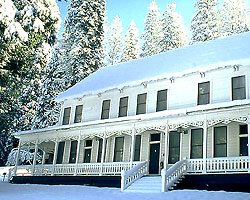 On the south side of the park at the charming, Victorian-era Wawona Hotel, a traditional Dickens' Christmas gets underway in mid-December. Riding the edge of Wawona Meadow like a glistening white ocean liner, this is the oldest resort hotel in the state, founded in 1856 and now a National Historic Landmark. Brought from outside the park are cedar and pine garlands, and arrangements of flowers, pine cones, berries, pomegranates, oak leaves, and lichen balls—an aromatic array. The lobby Christmas tree is lit at a special occasion complete with hot chocolate, cider and cookies, while resident musician, Tom Bopp, plays on a 1906 grand piano, leading guests in Christmas carols. Live music and caroling is planned for other evenings, and fireside readings of "A Christmas Carol." You can bring gifts to the front desk on Christmas Eve, for Santa to present that afternoon before he reads Christmas stories and sits for photos with the kids. Ask for the printed, self-guided tour of the vintage photos in the lobby, which show the early days when guests arrived on horseback and in stagecoaches and huge sequoias were cut with handsaws.
On the south side of the park at the charming, Victorian-era Wawona Hotel, a traditional Dickens' Christmas gets underway in mid-December. Riding the edge of Wawona Meadow like a glistening white ocean liner, this is the oldest resort hotel in the state, founded in 1856 and now a National Historic Landmark. Brought from outside the park are cedar and pine garlands, and arrangements of flowers, pine cones, berries, pomegranates, oak leaves, and lichen balls—an aromatic array. The lobby Christmas tree is lit at a special occasion complete with hot chocolate, cider and cookies, while resident musician, Tom Bopp, plays on a 1906 grand piano, leading guests in Christmas carols. Live music and caroling is planned for other evenings, and fireside readings of "A Christmas Carol." You can bring gifts to the front desk on Christmas Eve, for Santa to present that afternoon before he reads Christmas stories and sits for photos with the kids. Ask for the printed, self-guided tour of the vintage photos in the lobby, which show the early days when guests arrived on horseback and in stagecoaches and huge sequoias were cut with handsaws.
Few visitors enter the wondrous winter world of Yosemite, making it all the more enchanting for those of us who do. Whether dozing by a blazing log fire, walking in a forest sprinkled with snowflakes, or meeting up with a furry coyote, the magic of Yosemite will warm your heart.
If You Go:
Winter Discounts
Mid-week, non-holiday visitors to Yosemite National Park enjoy winter lodging and ski package discounts (http://www.yosemitepark.com). The park is open all year round; the lowest elevation, driest highway into the park in winter is Highway 140 from Merced to the Arch Rock entrance.
Skiing at Badger 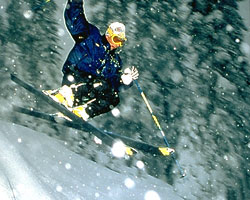 The oldest ski resort in the state, Badger Pass Ski Area opened in 1935 and is still one ofthe best ski mountains in the country for adult beginners and intermediates, and especially for kids learning to ski. Six lifts take skiers to the 8,000-foot summit, which receives about 180 inches of snowfall annually, for downhill skiing and snowboarding. Winter fun also includes snowshoeing, Nordic skiing and sliding on the tubing hills (http://www.BadgerPass.com). Within the park are 350 miles of cross-country ski trails and roads, with over 90 miles of marked trails and 40K of machine-groomed and skating lanes. You also join a ranger for a guided snowshoe hike to the Mariposa Grove of Giant Sequoias, or a ski trek to Glacier Point for an overnight adventure.
The oldest ski resort in the state, Badger Pass Ski Area opened in 1935 and is still one ofthe best ski mountains in the country for adult beginners and intermediates, and especially for kids learning to ski. Six lifts take skiers to the 8,000-foot summit, which receives about 180 inches of snowfall annually, for downhill skiing and snowboarding. Winter fun also includes snowshoeing, Nordic skiing and sliding on the tubing hills (http://www.BadgerPass.com). Within the park are 350 miles of cross-country ski trails and roads, with over 90 miles of marked trails and 40K of machine-groomed and skating lanes. You also join a ranger for a guided snowshoe hike to the Mariposa Grove of Giant Sequoias, or a ski trek to Glacier Point for an overnight adventure.
From January through March, during four days preceding the full moon and the night of the full moon, a naturalist ranger leads small groups from Badger on Full Moon Snowshoe Walks on a winding, 2.5 trail through a sparkling pine forest to a ridge to watch the moon rise over a flotilla of mountain peaks—quite a breathtaking sight. The wintertime activities of animals are described, and tales told of moony folklore. The snowy, moonlit landscape is bright as day and the heavens are scattered with stars, right down to the horizon.

